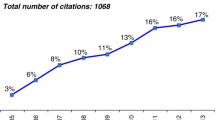Abstract
This paper investigates interactions between exporting and productivity at the firm level, using a panel of firms in the UK chemical industry. This is both highly technology intensive and the UK’s largest exporting sector. We find exporters are more productive than non-exporters, but are also on average smaller. This superior productivity performance among exporters appears to be caused by both self-selection and learning-by-exporting effects. In contrast to other studies, we find learning effects are significantly positive among new entrants, weaker for more experienced exporters and negative for established exporters. JEL no. F14, D21, L65
Similar content being viewed by others
References
Aw, B. Y., and A. R. Hwang (1995). Productivity and the Export Market: A Firm Level Analysis.Journal of Development Economics Vol. 47 (2): 313–332.
Bernard, A., and B. Jensen (1999). Exceptional Exporter Performance: Cause, Effect, or Both?Journal of International Economics Vol. 47 (1): 1–25.
Bernard, A., and B. Jensen (2001). Why Some Firms Export? NBER Working Paper 8349. National Bureau of Economic Research, Cambridge, Mass.
Bernard, A., and J. Wagner (1997). Exports and Success in German Manufacturing.Review of World Economics/Weltwirtschaftliches Archiv Vol. 133 (1): 134–157.
Castellani, D. (2002). Export Behaviour and Productivity Growth: Evidence from Italian Manufacturing Firms.Review of World Economics/Weltwirtschaftliches Archiv Vol. 138 (4): 605–628.
Clerides, M., S. Lach, and J. Tybout (1998). Is Learning by Exporting Important? Micro-Dynamic Evidence from Colombia, Mexico and Morocco.Quarterly Journal of Economics Vol. 113 (1): 903–904.
Delgado, M., J. Fariñas, and S. Ruano (2002). Firm Productivity and Export Markets: A Non-Parametric Approach.Journal of International Economics Vol. 57 (2): 397–422.
Girma, S., D. Greenaway, and R. Kneller (2003). Export Market Exit and Performance Dynamics: A Causality Analysis of Matched Firms.Economics Letters Vol. 80 (2): 181–187.
Girma, S., D. Greenaway, and R. Kneller (2004). Does Exporting Lead to Better Performance? A Microeconometric Analysis of Matched Firms.Review of International Economics (forthcoming).
Greenaway, D., and R. Kneller (2003). Exporting, Productivity and Agglomeration: A Difference in Difference Analysis of Matched Firms. GEP Research Paper 03/45. University of Nottingham.
Greenaway, D., J. Gullstrand, and R. Kneller (2003). Exporting May Not Always Boost Firm Performance. GEP Research Paper 03/26. University of Nottingham.
Greene, A. (2000). Econometric Analysis. Fourth Edition. London: Prentice Hall International.
Heckman, J. (1981). Statistical Models for Discrete Panel Data. In C.F. Manski and D. McFadden (eds.),Structural Analysis of Discrete Data with Econometric Applications. Cambridge, Mass.: MIT Press.
Helpman, E., and P. Krugman (1985).Market Structure and Foreign Trade. Cambridge, Mass.: MIT Press.
Helpman, E., M. Melitz, and S. Yeaple (2004). Export versus FDI.American Economic Review (forthcoming).
Jean, S. (2002). International Trade and Firms, Heterogeneity under Monopolistic Competition.Open Economies Review Vol. 13 (2): 291–311.
Kraay, A. (1999). Exports and Economic Performance: Evidence from a Panel of Chinese Enterprises.Revue d’Economie du Développment Vol. 1–2: 183–207.
Melitz, M. (2003). The Impact of Trade on Intra-Industry Reallocations and Aggregate Productivity.Econometrica Vol. 71 (3): 1695–1725.
Rhee, J., B. Ross-Larson, and G. Pursell (1984).Korea’s Competitive Edge: Managing the Entry into the World Markets. Baltimore: Johns Hopkins University Press.
Roberts, K., and J. Tybout (1997). The Decision to Export in Colombia: An Empirical Model of Entry with Sunk Costs.American Economic Review Vol. 87 (4): 545–564.
Wagner, J. (2001). A Note on the Firm Size-Export Relationship.Small Business Economics Vol. 17 (4): 229–237.
Wagner, J. (2002). The Causal Effect of Exports on Firm Size and Labour Productivity.Economics Letters Vol. 77 (2): 287–292.
Wagner, J. (2003). Unobserved Firm Heterogeneity and the Size-Export Nexus.Review of World Economics/Weltwirtschaftliches Archiv Vol. 139 (1): 161–172.
World Bank (1993).The East Asian Miracle. New York: Oxford University Press.
Author information
Authors and Affiliations
Corresponding author
About this article
Cite this article
Greenaway, D., Yu, Z. Firm-level interactions between exporting and productivity: Industry-specific evidence. Rev World Econ 140, 376–392 (2004). https://doi.org/10.1007/BF02665981
Issue Date:
DOI: https://doi.org/10.1007/BF02665981




